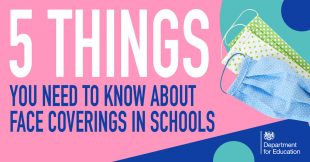
The way children are taught at school hasn’t actually changed much since the start of the pandemic and throughout, the government has prioritised education.
The main differences are the additional safety measures in place, including the use of face coverings. Along with social distancing and good hand washing, face coverings are an effective way to help prevent the spread of coronavirus.
Here are five things you need to know about face coverings in school:
1. Primary school pupils do not need to wear them
Where pupils in Year 7 and above are educated, face coverings should be worn by staff and pupils alike including in classrooms, when moving around buildings and in communal areas. Face coverings do not need to be worn by pupils when they’re outside.
This doesn’t apply in situations where wearing a face covering would impact on the ability to take part in exercise or strenuous activity, for example in PE lessons.
Our guidance is clear that children in primary school do not need to wear a face covering and should not be asked to wear one.
In primary schools, we recommend that face coverings are be worn by staff and adult visitors.
2. Some people are exempt from wearing face coverings
Some people don’t have to wear face coverings. This applies to people who:
- Can’t put on, wear or remove a face covering because of a physical impairment or disability, illness or mental health difficulties
- Speak to or provide help to someone who relies on lip reading, clear sound or facial expression to communicate.
The same exemptions should be applied in schools and colleges and we would expect teachers and other staff to be sensitive to those needs, noting that the reasons for this may not be visible to others.
3. If everyone wears a face covering the risk for all goes down
By encouraging pupils and staff to wear face coverings in secondary schools and colleges, alongside the other infection control measures in place, we are creating a safer environment for all. The best available scientific evidence is that, when used correctly, wearing a face covering may reduce the spread of coronavirus droplets in certain circumstances, helping to protect others.
The main job of face coverings is to reduce the number of virus-carrying particles that an infected person might emit - so if everyone wears one, the risk for all goes down.
Because face coverings are mainly intended to protect others rather than the wearer, they are not a replacement for social distancing and regular hand washing.
4. Cloth masks are breathable and will not block oxygen
There have been concerns that cloth face coverings can reduce oxygen intake and can lead to low blood oxygen levels. However, cloth masks are made from breathable materials that will not block the oxygen your child needs.
Wearing a face covering will not affect your child's lungs from developing normally. This is because oxygen flows through and around the mask, while blocking the spray of spit and respiratory droplets that may contain the virus. Keeping your child's lungs healthy is important, which includes preventing infections like coronavirus.
5. Face coverings are a temporary measure
The use of face coverings is one element of the wider safety measures schools and colleges have put in place. This is a temporary measure and will be reviewed at Easter, in partnership with health experts, to decide whether evidence suggests that these measures can be eased ahead of the summer term.
More information on our face covering guidance is available on gov.uk.